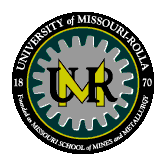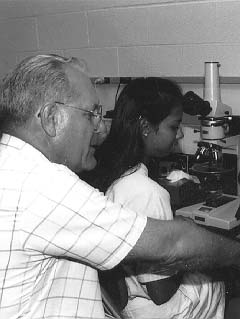|

|
|
Educating Tomorrow's Leaders
in the Geological Sciences
|
|
|
|
|
|
|
|
|
|
|
|
|
|
|
|
|
|
|
|
|
|
|
|
|
|
|
|
|
|
|
|

|
Richard D. Hagni
|
Curators' Professor and Chairman
|
|
Ph.D., 1962, University of Missouri-Columbia
|
|
M.S., 1954, Michigan State University
|
|
B.S., 1953, Michigan State University (BSc)
|
|
Address:
|
Department of Geology & Geophysics,
University of
Missouri-Rolla, Rolla, Mo. 65409-0410
|
|
Office:
|
125 Mcnutt Hall
|
|
Phone:
|
(573) 341-4657
|
|
Fax:
|
(573) 341-6935
|
|
E-mail:
|
rhagni@umr.edu
|
|
|
|
|
|
|

Volume Contains
28 Papers
in 412 Pages
|
* * * NEW * * * NEW * * * NEW
* * * NEW * * *
Studies on Ore Deposits, Mineral
Economics,
and Applied Mineralogy: With Emphasis on
Mississippi Valley-type Base Metal and
Carbonatite-related Ore Deposits
Click
Here for More Information
|
Richard D. Hagni has taught and conducted research at the
University of Missouri-Rolla since 1956. He received his B.S. and
M.S. degrees from the Michigan State University in 1953 and 1954; the
Ph.D. degree from the University of Missouri-Columbia in 1962. He is
an economic geologist with interests in a wide variety of ore
deposits, both domestic and abroad. Although he is interested in all
aspects of ore deposits, he especially emphasizes the application of
ore microscopy and related techniques (SEM-EDS, EPMA,
cathodoluminence microscopy, infrared microscopy, and fluid inclusion
studies) to the study of ore deposits. He teaches more courses in ore
microscopy than anywhere in the United States: Ore Microscopy,
Advanced Ore Microscopy, and Applied Ore Microscopy. His course on
Ore Deposition involves the principles of how ore deposits are
formed, but especially features well-illustrated lectures on ore
deposits that he has visited throughout the world. His Advanced Ore
Microscopy course includes the involvement with the ore microscopy of
advanced ore suites, quantitative Vickers Hardness measurements,
reflectance measurements to 0.1%, quantitative color determinations,
fluid inclusion temperature and salinity measurements,
cathodoluminescence microscopy, infrared microscopy, SEM-EDS, EPMA,
Auger microprobe and ESCA. The ore microscopy laboratory at UMR is
probably the only laboratory in the United States to have all four
types of quantitative equipment: 1) Vickers Hardness, 2) reflectance,
3) rotation properties, and 4) precise color comparison bar. The
polished section collections may be the most extensive in the United
States, and include a large number of suites of polished sections of
ores from throughout the world.
• List
of polished section suites studied in Ore Microscopy 312 and
Advanced Ore Microscopy 412 - Table II.
• Photomicrographs illustrating
ore suites studied in Ore Microscopy, Geology 312
• Photomicrographs
illustrating ore suites studied in Advanced Ore Microscopy,
Geology 412
The research interests of Richard D. Hagni lie in two major areas: 1)
economic geology and 2) applied mineralogy. As an economic geologist,
he has an interest in all aspects regarding ore deposits, primarily
metallic ore deposits, but also non-metallic ones, especially
fluorspar deposits. He is especially active in the application of ore
microscopic and related microscopic techniques to the study of ore
deposits to determine their mineralogy, ore textures, paragenesis,
and genesis. He has been especially involved in studies of the
Cu-Pb-Zn ores in the Viburnum Trend in southeast Missouri (one
hour’s drive from Rolla). Current studies by Hagni and students
working with him on those ores include the areal distributions of ore
minerals abundances and grain sizes, studies of galena morphological
variations, determinations of trace element contents (especially
silver) in pyrite and marcasite, sulfide mineral paragenesis,
underground mapping of mineral zoning, ore microscopy of unusually
fine-grain Pb and Cu ores, ore microscopy and trace element contents
of the rare bornite ores. He has also has been actively involved in
studies of copper shale and sandstone deposits in Oklahoma, iron
deposits in Michigan, New York, Alabama, and Missouri, gold deposits
in Nevada, silver deposits in Idaho, and massive sulfide deposits in
New Hampshire and Maine. Recent studies have included mine mapping,
ore microscopic, petrographic, cathodoluminescence microscopic, and
geochemical studies of the carbonatite-related Okorusu fluorspar
deposits in Namibia and the carbonatite-related Nb and REE deposit at
Eldor in Quebec. Recently, he has visited the East African Rift in
Kenya and Oldoinyo Lengai carbonatite volcanoe in Tanzania; field
photographs of those geological features can be viewed by clicking
that topic below. More recently, he has recently visited the
carbonatite-related fluorspar deposits at Amba Dongar, India, and has
plans to conduct research to compare those deposits to the similar
deposits at Okorusu, Namibia.
•
Outline of Ore Deposition 489 and List of ore deposits discussed -
Table I
• Photomicrographs illustrating
ore deposits discussed in Ore Deposition, Geology 489
• East African Rift and Oldoinyo
Lengai
• Selected
recent papers published on ore deposits
Hagni extends his ore microscopic studies to applications for the
resolution of metallurgical, ceramic, and other important industrial
problems. In this regard, he clearly has been more active than any
other ore microscopist in the United States. Most of the case
histories of applied ore microscopy dealt with in his Applied Ore
Microscopy course have come from his personal industrial experiences.
The application of ore microscopy to certain industrial problems
commonly can serve to save millions of dollars for industrial firms.
For 12 years, Hagni and students working with him served as the
process mineralogy group in the Pyrometallurgical Research Center
that was funded by the U.S. Bureau of Mines, headquartered at UMR,
and conducted pyrometallurgical research throughout the United
States.
• Outline
of Applied Ore Microscopy Course - Problem Suites - Table
III
• Photomicrographs
illustrating ore suites studied in Applied Ore Microscopy, Geology
435
• Selected
recent papers published on applied mineralogy
Hagni held the Gulf Oil (Gulf Minerals) Chair at UMR from 1984 to
1992. He was named Curators’ Professor of Geology in 1993 and
has held that Chair to the present time. He has served as the
Chairman of the Department of Geology and Geophysics from 1985 to the
present. Since 1986, he has served three terms as the Chairman of the
Paragenesis Commission (PaC) of the International Association on the
Genesis of Ore Deposits (IAGOD). He has served three terms as the
Chairman of the Process Mineralogy Committee of AIME. Since 1990, he
has served two terms as the Chairman of the Commission on Applied
Mineralogy (CAM) of the International Mineralogical Association
(IMA). He also has served in several offices, including
Vice-president, of the International Council on Applied Mineralogy
(ICAM). He is the author/editor of 22 books, published 149 papers and
given 273 abstracted professional presentations.

